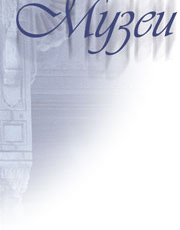
Turkmenia

Bowls
Site of Chongdepe, South Turkmenia, Central Asia. 4th or 3rd millennium BC
Clay, with slip decoration.
Height 7.7 cm and 11.4 cm; diameter 18.2 cm and 21 cm. Inv. Nos 4858 III and 4861 III
Received in 1964 from the Institute of Archaeology (found in 1963 at the site of Chongdepe), Moscow.
These thin-sided vessels of baked clay represent the material culture of the most ancient agricultural tribes of South Turkmenia. They were made by hand on the wheel and painted with red and brown-black slips. Various geometric or zoomorphic motifs were characteristic of Copper Age pottery produced in South Turkmenia. Apart from their purely decorative function they were held to possess certain symbolic value. For instance, they might have been thought to have the power to protect the vessels and their contents from all kinds of damage. In the ancient times goats were worshipped as sacred animals and might have also been treated as totems. The stylized representations of goats on the Chongdepe bowls form part of the decorative frieze in which they alternate with geometric motifs. The decor as a whole seems to possess some symbolic meaning, but its interpretation unfortunately has been lost.
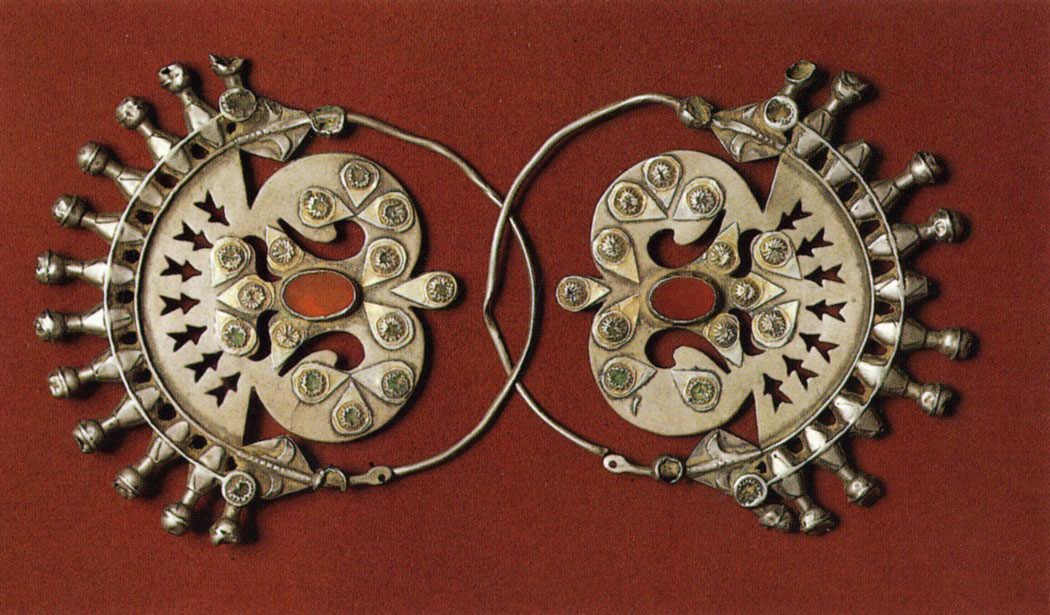
Gulak-khalkah earrings
The Yomud ethnic group, Turkmenia. Late 19th century
Silver, stamped and engraved, with cornelians.
Length 10 cm, diameter 9 cm. Inv. No.6628 III
Acquired in 1971 from a private collection. First publication.
Personal adornments were part and parcel of a Turkmen woman's traditionally dark and austere costume. In the 19th and early 20th centuries, Turkmen jewellers produced a vast variety of ornaments of different types and shapes, each of which had its own specific function. Some ornaments were designed for everyday wear, while others were meant exclusively for festive and ceremonial occasions. As a rule, ornaments of the latter type were produced in suites. The designs, decor, materials and techniques of jewellery-making were determined by century-old traditions of the craft.
Articles of jewellery made by various ethnic groups of Turkmenia differed in certain stylistic traits and techniques. But for all the distinctions, they possessed general features distinguishing them from the ornaments of other Central Asiatic peoples. These earrings are remarkable for the elegant simplicity of design characteristic of all Turkmen ornaments. Although made for everyday wear, they are not devoid of festive beauty and charm.

Female ornaments for festive occasions
The Tekke ethnic group, Turkmenia. Late 19th century
Bukau pectoral
Silver, gilt, stamped and engraved, with cornelians.
Height 45 cm, width 24 cm. Inv. No. 4015 III
Received in 1956 from the Art Museum of Turkmenia, Ashkhabad Cuff bracelets
Silver, gilt and engraved, with cornelians.
Height 12.5 cm, diameter 7.5 cm. Inv. No.6929 III
Acquired in 1972 from a private collection.
Articles of Turkmen jewellery are distinguished by their size and by the strictness of their geometric or plant designs. The decoration is mostly flat, i. e. engraving prevails over chasing, stamping or granulation. Flat or relief studs of dark cherry-coloured or golden cornelian or glass are almost obligatory.
The necklace of the bukau type reproduced here consists of a flat neck-ring and a large plate decorated with gilt ornamentation and flat cornelian inlays. A fringe of rustling pendants made of chains- a typically Turkmen feature found in many ornaments-is suspended from the plate. Ornaments of the Tekke group were usually rather big and heavy, like the cuff bracelets reproduced here. Such twin non-flexible bracelets were worn one on each arm, and were often wide enough to cover it from wrist to elbow. They consist of five tiers of cornelian studs standing out against the richly ornamented gilt background. Their size and mas-siveness are evocative of the vambraces worn by medieval knights.
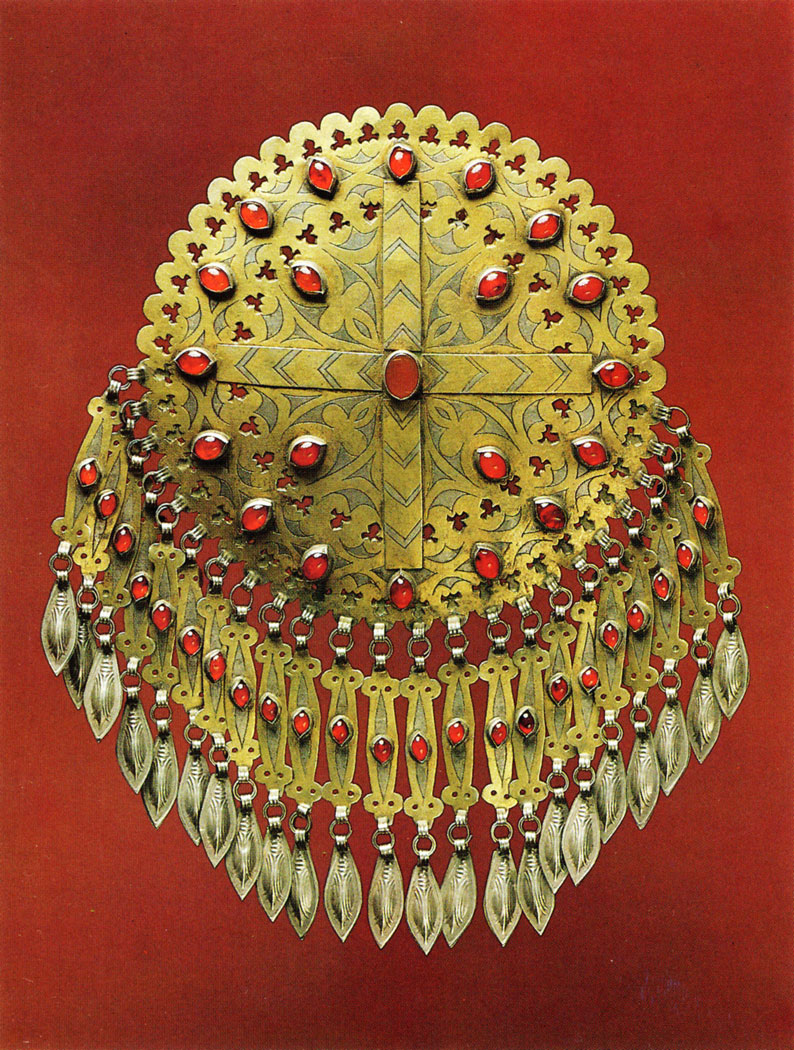
Gül-yakah female pectoral
The Tekke ethnic group, Turkmenia. Late 19th or early 20th century
Silver, gilt, stamped and engraved, set with cornelians and glass.
Diameter 17 cm. Inv. No. 30579 К
Acquired in 1981 from a private collection. First publication.
Gül-yakah (a flower under the collar) is perhaps one of the favourite and most widely spread ornaments worn by Turkmen women. Like a brooch or a clasp it fastened the neck of the dress. Pectorals of this type were of different sizes, the largest being almost as big as a sunflower. Some pectorals resemble the sun which shows that gül-yakahs were probably symbols of the ancient solar cult. It was not accidental therefore that such ornaments were designed for women who since time immemorial had been honoured in Turkmenia as foremothers giving life, goodness and well-being. Gül-yakah was a symbol of goodwill and happiness.
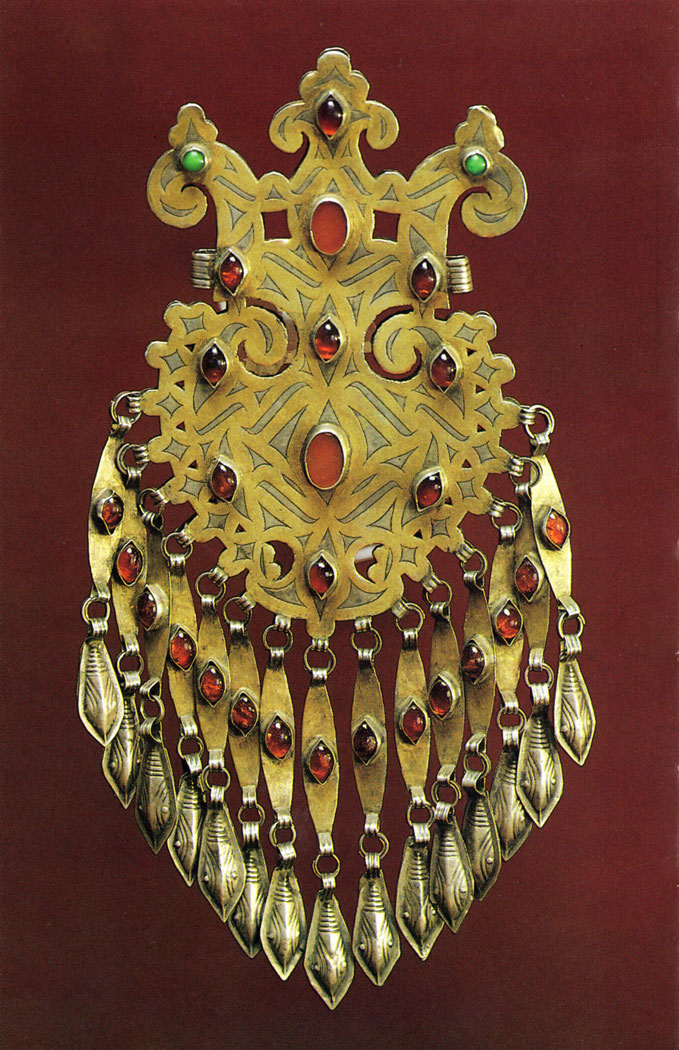
Dagdan female pectoral
The Tekke ethnic group, Turkmenia. Late 19th century
Silver, gilt, engraved and stamped, decorated with cornelians and glass and paste inlays.
Length 25 cm, width 10.5cm. Inv. No. 6920 III
Acquired in 1972 from a private collection. First publication.
According to popular beliefs, dagdan pectorals protected their owners from evil spirits and ailments. They were of various sizes and shapes, but the most widely occurring types are shaped as beetles, or frogs or combining features of both.
The present pectoral, remarkable for excellent workmanship, is relatively small. Its laconic and well-proportioned form with elaborate edges is reminiscent of a beetle. Its lower edge has loops, to which two-part pendants-narrow plates set with cornelians and shelpe-type plates with stamped decoration-are affixed.
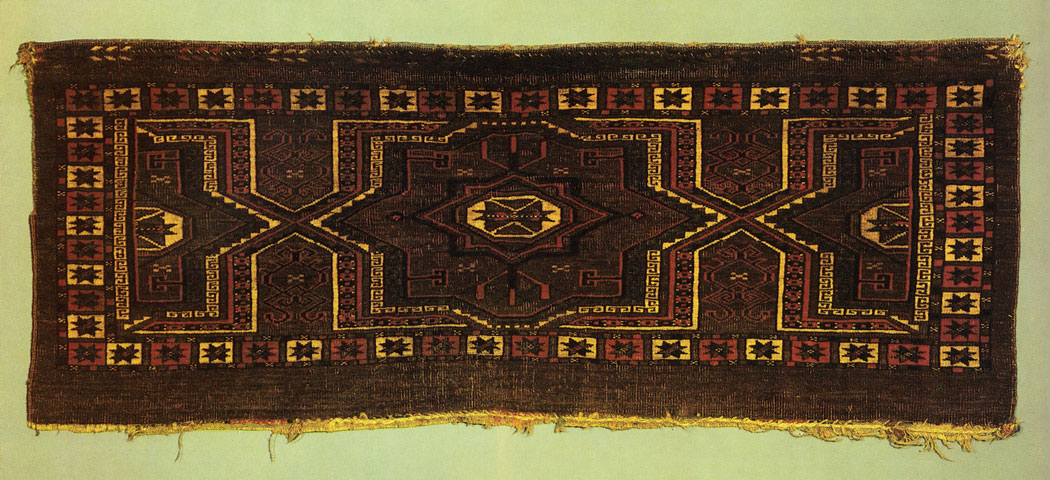
Mafrach bag
The Salor ethnic group, Turkmenia. Mid-19th century
Pile-woven wool.
60 × 148 cm. Inv. No. 1265 III
Acquired in 1930.
Felt bags of various shapes and sizes were indispensable accessories in the everyday life of Turkmen nomads. They were convenient for storing and carrying various household articles and food. Large bags were called chuvals and smaller ones- mafraches.
Members of the Salor ethnic group have been traditionally regarded as the founders of Turkmen carpet-making. However, their carpet-making was never on a large scale. Their rugs and carpets, without displaying a large variety of forms, long preserved the earliest traditional features of decor and techniques. For various historical reasons the Salors ceased producing carpets a long time ago. Each carpet was a rarity in its own way and was carefully preserved by its owners as a family treasure. Therefore Salor carpets are now very rarely to be found in private or museum collections, every specimen being treasured as a precious relic of the ancient art.
This mafrach bag was produced by the Choudors, an ethnic group which adopted the Salors' traditions. Its highly original decor combines monumental ornamentation of the central surface with an exquisite border design in which the same motif of star-shaped medallions is treated on a different scale. The colours are noble and deep.
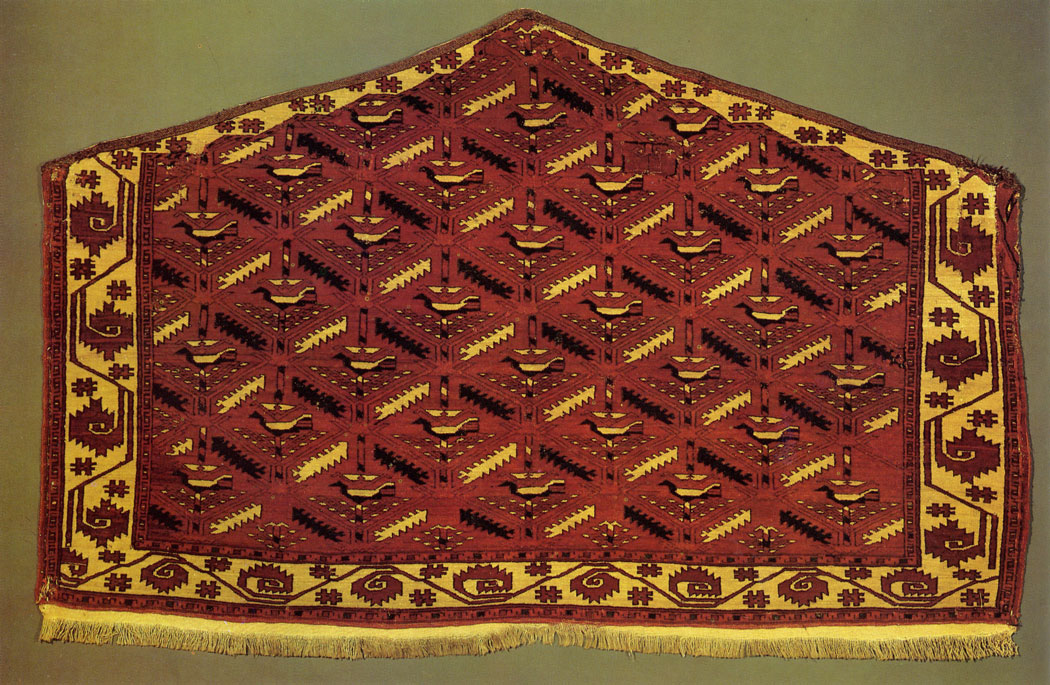
Asmaldyk rug
The Yomud ethnic group, Turkmenia. 18th or early 19th century
Pile-woven wool.
132 × 83 cm. Inv. No. 1085 III
Acquired in 1925.
Asmaldyk is a type of carpet used up to the 20th century exclusively by representatives of the Yomud ethnic group. This peculiarly shaped-pentagonal or, sometimes, heptagonal-rug was designed for decorating camels' backs during wedding processions. Two such rugs-one on each side-were hung on top of the camel-cloth on the camel which was to take the bride to the bride-groom's house. Asmaldyks were usually decorated with zoomorphic motifs and their colouring was rich and varied.
The asmaldyk reproduced here is in away a unique specimen of its kind. Its pale-red background is covered with a repeated rhomboid pattern formed of white and blue stylized leaves. Inside each rhombus there is a stylized bird. The elaborately ornamented main field of the rug is framed with a border adorned with a geometrically stylized plant pattern.
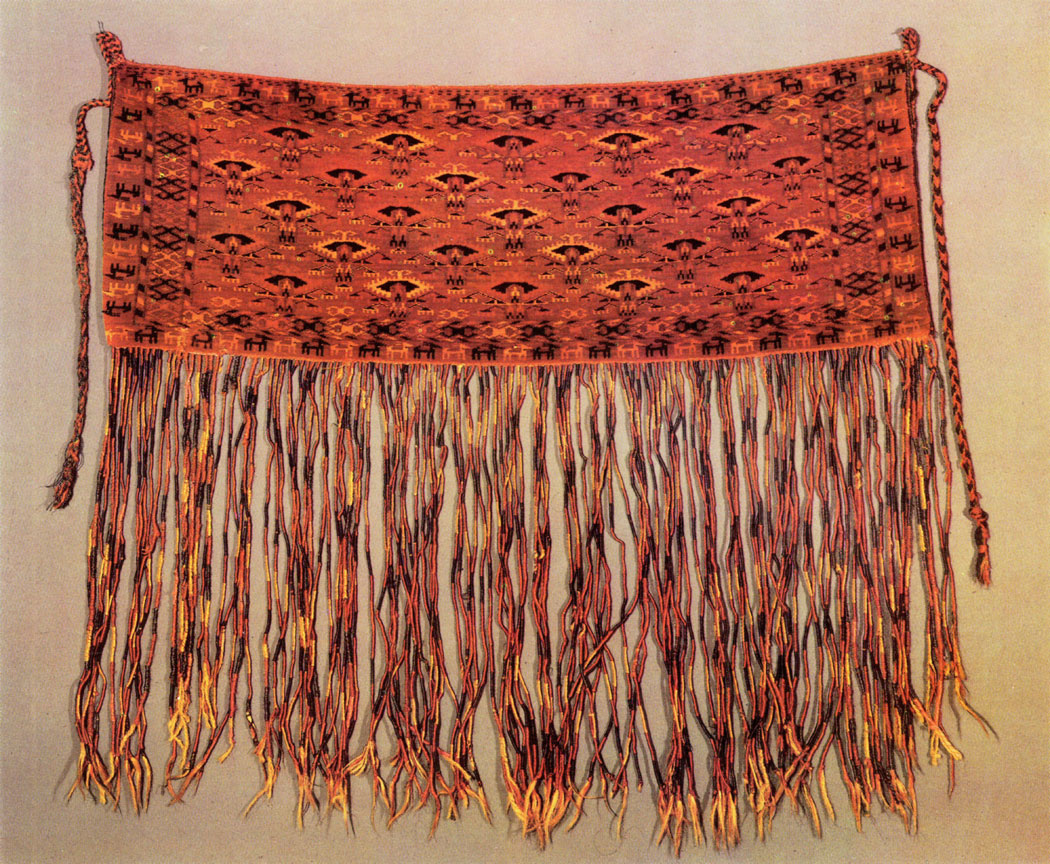
Germech carpet
The Tekke ethnic group, Turkmenia. Mid-19th century
Pile-woven wool.
75 × 26 cm. lnv. No. 2645 III
Acquired in 1937 from a private collection.
Turkmen carpets of the 18th and 19th centuries were known far beyond Central Asia for their beauty and durability. Carpet-making in Turkmenia was a woman's craft. Carpets were made in every family, and the materials used were high-quality sheep wool and natural pigments. The nomadic way of life required both a great variety of articles made of carpets and their durability. Carpets accompanied nomads throughout their life- from the first day to the last. They were used instead of furniture and decorated the interior of the nomad's yurtas (tents). Different Turkmen tribes favoured different ornamental compositions and colours. The basic motif almost universally found in all Turkmen carpets is the geometrically stylized rosette, or golконецформыначалоформы, which, in different localities, was also treated differently. The patterns and their arrangement in various articles were mastered to perfection by generations of carpet-makers and depended in each particular case on the function of the article. But however faithfully observed, traditional canons always provided room for the self-expression of a truly creative personality. This germech belongs to those articles which have a distinctly original touch in the decorative treatment. Carpets of this kind were used as door-curtains inside the yurta.
Horserace
By Ruvim (llya) Mazel (1890-1967). Turkmenia. 1928
Watercolours on paper.
188 × 47 cm. Inv. No. 1642 III
Received in 1939 from the State Purchasing Commission (acquired from the artist), Moscow.
Ruvim Mazel was born in Vitebsk. He studied at a private studio in Vitebsk (1 902-6), at the school of the Society for the Encouragement of Arts in St. Petersburg (1 906-9) and the Academy of Arts in Munich (1910-14). Later he headed the School of Art of the East in Ashkhabad (1921-24). He contributed greatly to the training of local artists. From 1 924 Mazel lived and worked in Moscow. He was active both as an easel painter and a graphic artist, striving to achieve a harmonious union of Western European pictorial principles with the traditions of Turkmen folk art (particularly, the traditions of carpet ornamentation).
The underlying theme of Ruvim Mazel's oeuvre is the life of the Turkmen village and nomad camps. His Horserace, like other pictures of this kind, is permeated with the artist's love for his country and its people. Mazel's works are remarkable for their ethnographic accuracy and verisimilitude.
Vintage
By Biashim Nurali (1900-1965). Turkmenia. 1929
Oil on canvas.
123 × 179 cm. lnv. No. 1725 III
Received in 1936 from the State Purchasing Commission (acquired from the artist), Moscow.
A People's Artist of Turkmenia and an Honoured Teacher of Turkmenia, Biashim Nurali was born in Ashkhabad. He studie at the School of Art of the East in Ashkhabad (1921-25) and at the Art and Industry Institute in Moscow (1926-30). Later Nurali taught at the Shota Rustaveli Art School in Ashkhabad (1942-48). He lived and worked in Ashkhabad.
Nurali is the first professional artist in Turkmenia. A farm-hand in his youth, he had not touched pencil or brush until he was twenty. His highly decorative works, dwelling on the old and the new Turkmenia, are life itself-simple and artless, full of kindness and the mutual understanding of people.
Vintage is one of the artist's best pictures. It is pervaded with a warm feeling and characterized by a highly original artistic manner. Its charm lies in its sincerity, spiritual purity and poetical lyricism. Its intense brushwork seems to have absorbed the harmony of colours from the beautiful Turkmen carpets.
News
By Kulnazar Bekmuradov (born 1934). Turkmenia. 1967
Oil on canvas.
109 × 145 cm. Inv. No. 23410 КП
Acquired in 1972 from an exhibition of works by young Turkmen artists, Moscow.
Kulnazar Bekmuradov studied first in Ashkhabad and later in Moscow, at the Cinema Institute (1958-63). Since 1962 he has been an active contributor to art exhibitions. He lives and works in Ashkhabad. Bekmuradov is one of the most original representatives of the new generation of Turkmen artists and contemporary Turkmen school of painting. His familiarity with the expressive devices of cinematography accounts for certain traits in his pictorial method-the unexpected and highly effective foreshortenings, the deliberate scarcity of detail and the restrained quality of colour and line.
|
ПОИСК:
|
© MUSEUMS.ARTYX.RU, 2001-2021
При использовании материалов сайта активная ссылка обязательна:
http://museums.artyx.ru/ 'Музеи мира'
При использовании материалов сайта активная ссылка обязательна:
http://museums.artyx.ru/ 'Музеи мира'